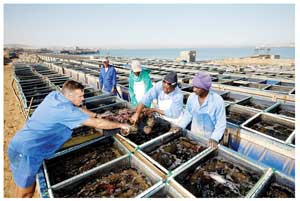
Let them eat Perlemoen

Rassie Erasmus started farming perlemoen on an experimental basis in 2004. Perlemoen has never been farmed commercially in Namibia, but today this modest enterprise employs up to 40 people seasonally.
Knowing the demand for abalone, Rassie and Renate Erasmus established Lüderitz Abalone Farming in 2002. It is the first and only land-based abalone farm in Namibia, producing the Haliotis Midae species, better known as the “Cape Perlemoen”.
“The biggest obstacle I faced was to make others see my vision and believe in my dream,” Rassie Erasmus said. His persistence paid off. With the help of finance from the Development Bank of Namibia, the farm has become an exporter of perlemoen, and a significant employer in Lüderitz.
The Erasmus’ abalone farm was high risk at start-up. “It was a dream, farming with this exotic creature. I knew it was very popular, in high demand and extremely profitable,” said Erasmus. “Due to its unpolluted and oxygen rich waters, Lüderitz is renowned for its top quality abalone, so we were perfectly situated for the abalone farm.”
After obtaining permission from the Ministry of Fisheries to perform a feasibility study, they imported 3000 juvenile p erlemoen, known as spat from South Africa. “The farm started with experimental trials in 2004 to see if the Perlemoen would adapt to the Namibian water and environment,” he said.
Within a few years, Lüderitz Abalone Farming gained more shareholders, which further strengthened the financial capacity of the organisation. Today, Lüderitz Abalone Farming employs between 20 and 39 people, depending on the harvesting and workload.












































